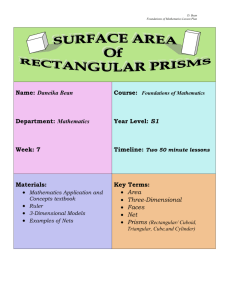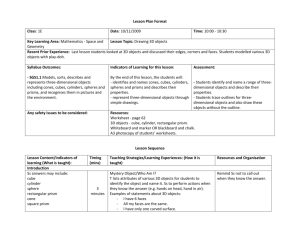Solid Figures: Volume and Area
advertisement
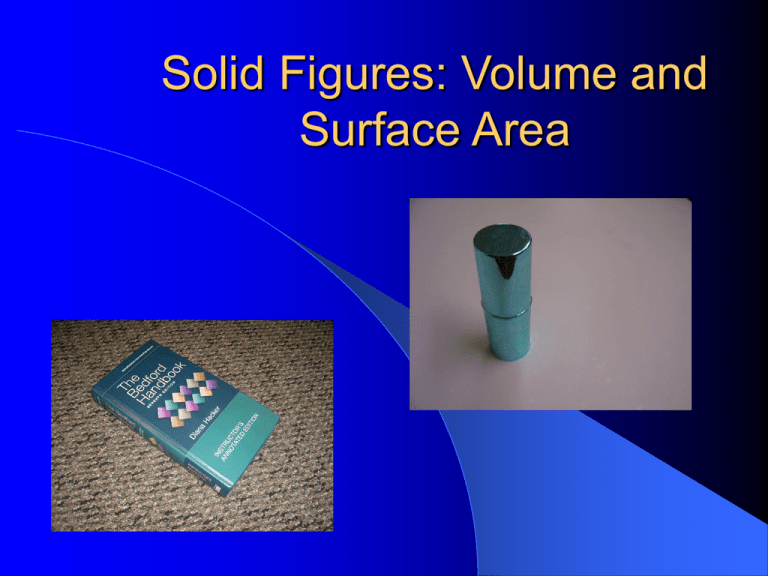
Solid Figures: Volume and Surface Area Let’s review some basic solid figures… Sphere A sphere is a ball. It has no faces, edges, or vertices. Cube A cube is like a box. It has six faces, six edges, and four vertices. All of a cube’s faces and edges are equal. Rectangular Prism A rectangular prism is also like a box. It has six faces, six edges, and four vertices. All of its faces are either squares or rectangles. Cylinder A cylinder is like a soup can. It has two circular faces on each end, but no edges or vertices. You could say that a cylinder is a “circular prism.” Finding Volume We’re going to talk about how to find the volume of rectangular prisms and cylinders. Volume: Rectangular Prisms The formula for finding the volume of a rectangular prism is volume = length x width x height, or V = l x w x h. Volume: Rectangular Prisms Suppose you have a rectangular prism that is 9 inches long, 6 inches wide, and 5 inches high. What is the volume of this rectangular prism? V=9x6x5 V = 270 cubic inches Volume: Cylinders The formula for finding the volume of a cylinder is pi x radius squared x height. Volume: Cylinders Suppose you have a cylinder with a height of 8 centimeters and a radius of 12 centimeters. What is the volume of this cylinder? V = 3.14 x (8)^2 x 12 V = 2,411.52 cubic centimeters Finding Surface Area Now we’re going to talk about how to find the surface area of rectangular prisms and cylinders. Surface Area: Rectangular Prisms The formula for finding the surface area of a rectangular prism is 2(length x width) + 2(length x height) + 2(width x height). Surface Area: Rectangular Prisms Suppose you have a rectangular prism that is 7 meters long, 3 meters high, and 4 meters wide. What is the surface area of this rectangular prism? SA = 2(7 x 4) + 2(7 x 3) + 2(4 x 3) SA = 2(28) + 2(21) + 2(12) SA = 56 + 42 + 24 SA = 122 square meters Surface Area: Cylinders The formula for finding the surface area of a cylinder is SA = (2 x pi x radius squared) + (2 x pi x radius x height) Surface Area: Cylinders Suppose you have a cylinder with a height of 6 feet and a radius of 2 feet. What is the surface area of this cylinder? SA = (2 x pi x 2^2) + (2 x pi x 2 x 6) SA = (2 x 3.14 x 4) + (2 x 3.14 x 12) SA = 25.12 + 75.36 SA = 100.48 square feet Remember… Since multiplication is commutative, it doesn’t matter what order you multiply your numbers in when you find volume.

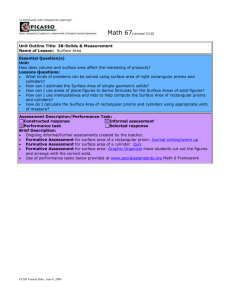


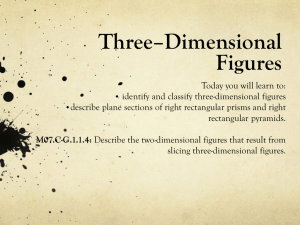

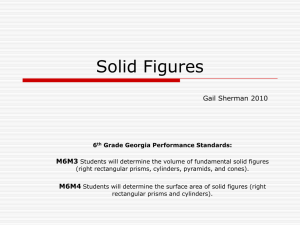
![Volume of Prisms and Cylinders [12/4/2013]](http://s2.studylib.net/store/data/005712570_1-e7691fc1893418ebe51c7a30e9e35d27-300x300.png)

